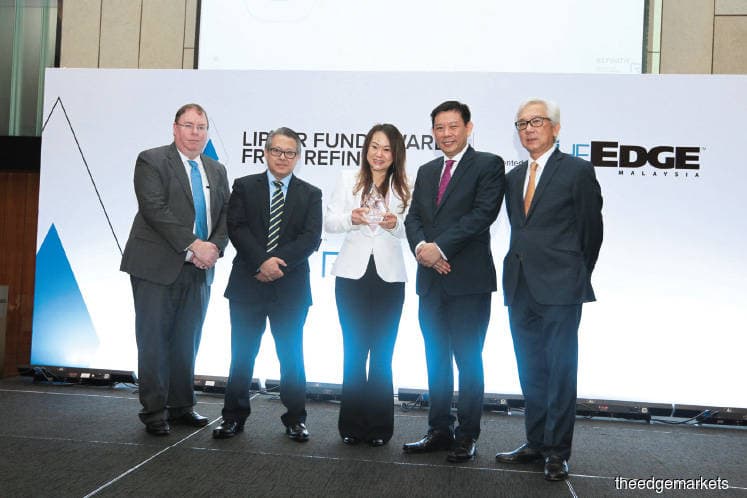
This article first appeared in The Edge Financial Daily on March 26, 2019
KUALA LUMPUR: Public Mutual Bhd repeated its winning feat by bagging 28 fund awards and one group award at the 2019 Lipper Fund Awards from Refinitiv yesterday. It broke the record for the most number of Lipper Fund awards won by a single company in a year.
Its chief executive officer (CEO) Yeoh Kim Hong said the fund house is very happy and proud of this achievement.
“The credit goes to our team of fund managers who have been working tirelessly to navigate the challenges last year. We would like to take this opportunity to express our gratitude to our unit trust consultants and unitholders for supporting us all these years,” she said.
The second biggest winner was Eastspring Investments Bhd, which won 12 fund awards and one group award. Other group award winners were Affin Hwang Asset Management Bhd, RHB Asset Management Sdn Bhd and Maybank Asset Management Sdn Bhd (MAMSB).
This marks the first Lipper award for MAMSB which won one fund award and one group award. Its CEO Ahmad Najib Nazlan attributed the success to a strong team and good investment process.
“The whole team is quite excited (over the win). I think it’s timely for us because we just completed a lot of corporate restructuring after the acquisition of Amanah Mutual Bhd and Singapore Unit Trusts Limited. Winning the award was a nice gift to start off the year,” he said.
In his keynote address, Eugene Wong, managing director of corporate finance and investments at Securities Commission Malaysia, said fund managers must educate investors about the benefits of socially responsible investing (SRI) and create more SRI investment opportunities. This is driven by the increasing demand for such products, especially from the millennial generation.
“It is clear that sustainability is becoming more important by the day. In the United States, assets under management using sustainable and responsible investing strategies grew from US$8.7 trillion in 2016 to US$12 trillion in 2018, representing 26% of assets under management. The European Sustainable Investment Forum reports that growth in the European SRI retail market increased by 800% from 2013 to 2018,” Wong said. Assets and businesses that damage the environment may eventually lose their economic value or have to be impaired and stranded, he added.
Technology is also disrupting the fund management industry, with studies forecasting that passive investing is expected to take over active investing in some markets. But Wong believes that actively-managed funds still have an important role to play in financial markets.
“Actively-managed funds support fair valuation through investment research. This research benefits the entire market and passive funds themselves. The participation of actively-managed funds in initial public offerings helps capital formation and price discovery. Actively-managed funds can also help promote good governance if they monitor their investments and exercise their voting rights,” he said.
Fund managers must relook at how they can draw investors with their value proposition, Wong added, including a review of how returns and costs are matched.
Xav Feng, director of Lipper Asia Pacific Research, Refinitiv, said there was a total continuing net inflow of US$532 billion in the global fund markets last year.
“Money markets posted the largest net inflow for 2018 with US$237 billion, equity with US$175 billion and mixed asset with US$117 billion,” Feng said. But huge fluctuations occurred in the fourth quarter, with the bond, equity and mixed asset categories all posting net outflows for that quarter.
As for the key regions, the US saw the largest net inflow of funds in 2018. The top sectors for net inflows were money market (USD) and global equities excluding US equities. High-yield bonds (USD) posted the highest net outflow.
“As for Malaysia, after nearly US$10 billion net inflows for 2017, there was a total net inflow of US$5.3 billion in 2018. The sector that enjoyed the highest net inflow was money markets (MYR) and Asia Pacific equities excluding Japan,” Feng said.
There was no overall group winner this year because none of the companies met the criteria for the award. According to Feng, an overall group winner has to win at least three equity, three bond and three mixed asset awards with over three years of historical performance.
Among the reasons contributing to this situation include the liquidation or merging of funds, Feng added. “We also did a reclassification of some funds because we are reviewing Malaysia’s (funds) classification and portfolio.”
The Edge Media Group’s publisher and group CEO Datuk Ho Kay Tat said in his welcome speech that in 2018, fund managers shared their views with The Edge readers on how to navigate through the ongoing geopolitical tensions and market volatility.
“This year, they see worries surrounding the US-China trade war and Brexit uncertainties dictating the direction of the markets and asset prices. On the local front, investors are waiting to see further clarity on government policies and their plans going forward. In the midst of this, many experts remain positive that there will be sweet spots for investors to preserve, grow and manage their wealth,” he said.
Apart from Wong and Ho, Badrul Hisham Dahalan, head of quantitative and performance analysis department at the Employees Provident Fund and Steven Carroll, head of Asean at Refinitiv were also presenters at the awards.
This year, a total of 79 awards were given, encompassing five group awards, 20 awards for conventional funds, 36 awards for provident funds and 18 awards for Islamic funds.
Following the rebranding of Thomson Reuters to Refinitiv, the Awards is now known as the Lipper Fund Awards from Refinitiv, with The Edge Malaysia as its official presenter. The 2019 awards marks the 20th year of collaboration between The Edge Communications Sdn Bhd and Refinitiv.
An in-depth coverage of the event and winning companies will be available in the April 1 issue of The Edge Weekly.